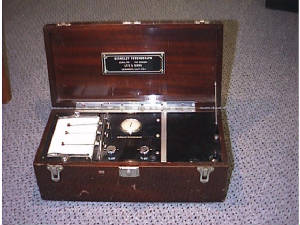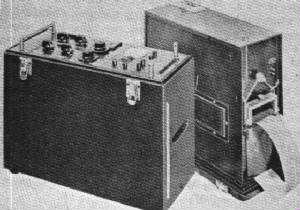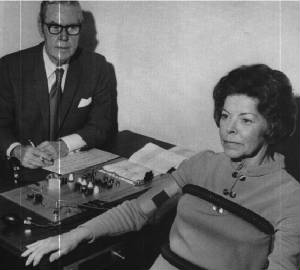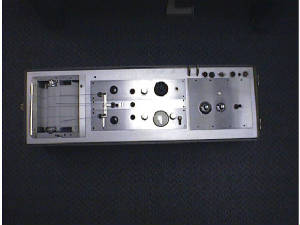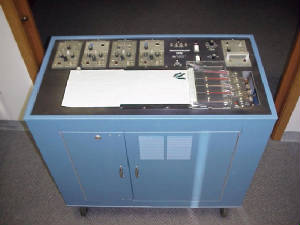|
|
|
Rare and Unique Polygraph Instruments
Berkeley Psychograph
The Berkeley Psychograph is a three channel polygraph instrument
first introduced in 1926 by Clarence D. Lee and Sons of San Rafael, California. Clarence D. Lee
was a Captain with the Berkeley Police Department. Captain Lee tutored under Leonard Keeler, and August Vollmer, recognized
as the “fathers” of modern polygraph. He retired in 1937 to manufacture polygraph instruments for police
and private examiners. It has
three channels; a pneumograph, a cardiograph, and a stimulus marker. Although functionally similar to Keeler’s
instruments at the time, C.D. Lee altered the blood pressure unit to make the instrument more sensitive to changes in pulse
and blood pressure. Housed in a mahogany case with Bakelite finish, it was the favorite of police examiners. This particular instrument is Serial number #170.  $900, plus shipping and handling. Darrow Behavioral
Research Photopolygraph
In the early 1930's, C.W. Darrow developed his Photopolygraph. Manufactured
by the C.H. Stoelting Company it retailed for $999. It had five channels; pneumograph, cardiograph, galvanograph, a
stimulus marker, and one additional channel that could be used to record either an abdominal respiration, a gastrointestinal
balloon, a plethysmograph, or carotid or radial pulse.
It’s recording system was unique in that all tracings are
recording on photographic paper. It was used by the U.S. Bureau of Prisons at Lewisburg and the Narcotic Farm in Kentucky.
This instrument is not in the Polygraph Museum's collection. Photograph Courtesy of James Allan Matte. The
Reid Polygraph
In 1945, John E. Reid of Reid and Associates in Chicago, Illinois
developed what he called the “Reid Polygraph.” Besides recording blood pressure, pulse, respiration, and GSR,
this new polygraph instrument recorded muscular activity in the forearms, thighs, and feet. These muscular movements
were picked up from metal bellows under the arms and seat of the polygraph chair.
This instrument was the first instrument to use a movement sensor
to detect subject movement during the examination. The examiner in this picture is John E. Reid. It was manufactured by the C.H. Stoelting Company and was available only to examiners who were trained by John E. Reid
and Associates.
This instrument is not in The Polygraph Museum's collection. Photograph
Courtesy of John E. Reid and Associates.
The
Cleve Backster Special C.H. Stoelting
Company
The components for this unique polygraph instrument are from
a Stoelting Model #22500. The case, made of plywood, was hand made for Cleve Backster by a cabinet maker in New
York around 1960. This is one of six such instruments that Cleve Backster used to test audience reaction to television
shows for a commercial advertising agency. Cleve Backster reports that the six instruments were laid side by side in a 3 X 2 matrix, and
used to record emotional responses of subjects as they watched commercials to judge their effectiveness. Cleve sold it to Jim Allen of the Spokane County Sheriff’s Department upon his graduation from the Backster/Arthur
Polygraph School in 1961 for $600. Jim Allen used the instrument until 1963. The other five copies of this instrument
have been lost.
$300, plus shipping and handling. Narco Bio-Systems,
Inc. Physiograph CPM
This instrument is actually a medical instrument capable of
monitoring five separate physiological channels. The modules on the face of the instrument are interchangeable and individually
configurable. The fifth channel is a side mounted Electrocardiograph. The five separate channels can be recorded on either paper or transparencies. The transparencies can then be
projected using a common overheard projector. Little is known of it’s use as a polygraph instrument.
It is believed that the City of Windsor, Ontario tried to use this instrument as a polygraph. Standing three feet tall
and weighing over three hundred pounds, this would have been a handful for any examiner. Donated by the City of Windsor. |
